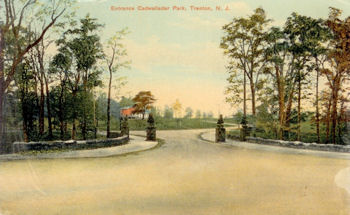When Edmund Hill’s letter reached Frederick Law Olmsted in March of 1890, Olmsted had established himself as America’s preeminent and most sought after landscape architect. At the time, he was actively engaged in several large projects, collaborating with Leland Stanford to convert his land into a university campus, drawing up plans for George Washington Vanderbilt’s 6,000-acre Biltmore estate, and getting ready to plan the grounds for the World’s Columbian Exposition of 1893 in Chicago.
Olmsted, however, was no stranger to New Jersey, having previously completed a commission for the Lawrenceville School in 1886.16 Now sixty-eight years old, Olmsted arrived in Trenton on April 11, 1890 to meet with Edmund Hill, who paid Olmsted’s expenses, and Lewis Lawton. They looked over the land for the park, then lunched with Hill in his temporary home, Cadwalader Manor, where Olmsted “gave us good advice.” Olmsted returned to Brookline the same day. That night, Hill wrote in his diary: “I am glad he came.”
The meeting must have gone well as the park committee officially selected Olmsted to prepare a plan for Cadwalader Park. Hill informed Olmsted of the decision on May 2, and on May 21 Olmsted returned to Trenton, this time bringing his stepson, John C. Olmsted.18 In the morning, they met with Hill and Elbridge G. Weir, a city surveyor. After looking over the park and land in the Cadwalader estate, Olmsted “gave us good ideas,” and they agreed “to have a topographical survey made of all our property.” They returned to Cadwalader Manor to meet with the rest of the park committee, where “Olmsted made suggestions” and “he settled on the land the park ought to have.” After the meeting, Hill “directed Weir to proceed.”
By the end of the month, Weir prepared a new and revised map for Cadwalader Park that reflected Olmsted’s suggestions and was, according to Hill, “more practical, has truer grades, reduces excavation, and is far better than Anderson’s.” On September 16, 1890, the park committee approved Olmsted’s preliminary plan for Cadwalader Park. Unfortunately, neither the preliminary plan of the park nor the many working drawings and more detailed maps prepared by the Olmsted firm survive. Olmsted’s park plans were stored in the Trenton Armory, which was destroyed during a raging fire in 1975, burning most of the original plans along with thousands of irreplaceable historical documents. |
One important plan discovered in Trenton’s City Hall in the 1970s is a lithograph of The Preliminary Plan of Cadwalader Park, dated September 17, 1891. According to Olmsted historian, Charles Beveridge, this plan “represents the final version of Olmsted’s design for Cadwalader Park.” Olmsted’s plan includes all his signature elements of park design: winding circuit drives and pedestrian paths, open meadows and groves of trees. The plan also anticipates the future development of Cadwalader Heights, identified as “Cadwalader Building Estate,” with Bellevue and Rutherford Avenues proposed to converge at Parkside Avenue, directly opposite the park. |
View and listen to a more recent history of the park
(by Chalres Webster IV, Historian - from WZBN TV)

